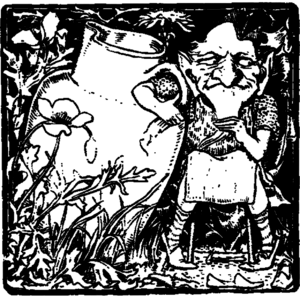Clurichaun facts for kids
The clurichaun (pronounced CLOO-ra-kawn) is a tricky fairy from Irish folklore. These fairies are known for hanging out in places where drinks are kept, like breweries, pubs, and wine cellars. They are often linked to the leprechaun and sometimes even thought to be the same. Like leprechauns, clurichauns are usually found alone, not in groups. They are also sometimes said to be shoemakers and protectors of hidden treasure.
Contents
Stories About Clurichauns
Clurichauns appear in many old Irish stories. They are often described as small, mischievous creatures.
Naggeneen, the Cellar Fairy
In a story from 1825, a clurichaun named Naggeneen lived in an Irish lord's wine cellar. He loved to drink and played lots of pranks on the servants. Naggeneen was described as a tiny man, only six inches tall, with a face like a wrinkled apple. He had bright, twinkling eyes and a nose that was red and purple. He wore a red nightcap, a short leather apron, light blue stockings, and shoes with big silver buckles.
When the lord found Naggeneen, the clurichaun cleverly talked him out of moving. Naggeneen hinted that he would just move with the lord, no matter where he went! This made the lord decide to stay put.
Billy Mac Daniel and the Clurichaun
Another tale tells of a young man named Billy Mac Daniel. One cold winter night, a clurichaun offered him a warm drink. Billy took the drink but didn't want to pay for it. Because of this, the clurichaun made Billy work for him for seven years and a day!
Billy eventually found a way to break free by asking for God's blessing. In this story, the clurichaun could pass through keyholes to get into homes and cellars. He could also turn bog rushes (a type of plant) into horses to ride. Clurichauns could even fly through the air on rushes, much like witches are said to fly on broomsticks.
Little Wildbean, the Helpful Trickster
Thomas Keightley shared a story in 1828 about a clurichaun named Little Wildbean. He was sometimes helpful but also got angry very quickly if he felt disrespected. Wildbean lived in the wine cellar of a gentleman named Mr. Harris. If a servant accidentally left a beer barrel running, Little Wildbean would wedge himself inside to stop the beer from flowing until someone turned it off.
His dinner was always left for him in the cellar. But one night, the cook only left him a small piece of herring and some cold potatoes. That midnight, Wildbean caused a lot of trouble for the cook, making her very uncomfortable and unable to get out of bed for three weeks. Like in the Naggeneen story, Mr. Harris tried to get rid of Wildbean by moving away. But he turned back when he saw the clurichaun had moved with him!
Clurichauns are also known as tricksters and practical jokers. They can make a lot of noise day and night, disturbing the peace in a house. Even with their troublesome nature, clurichauns often look after the family they live with. They try to protect their property and lives, as long as no one bothers them. This mix of being helpful and mischievous makes them similar to a domestic hobgoblin.
Clurichauns also enjoy smoking pipes. The small clay pipes sometimes found when digging are said to belong to them. They are also believed to know the secret of making beer from heather plants.
Other ways to spell clurichaun include cluracan, cluracaun, cluricaun, and cluricaune.
Clurichauns and Leprechauns
Even though clurichauns and leprechauns are usually seen as different types of fairies, they share some traits. Sometimes, clurichauns are also shown as shoemakers or guardians of treasure, just like leprechauns. A clurichaun might be seen carrying a jug of ale or wearing a leather apron with a hammer, whistling while he works.
They might also carry a magical purse. This purse could have a special coin (called the "lucky shilling") that always returns to the purse, no matter how many times it's spent. Or, the purse might always be full of money! Because of this, people often try to catch a clurichaun. But even if caught, they can vanish if their captor looks away for even a second. They sometimes carry two purses: one with the magic coin and one with a regular coin. If caught, they might offer the regular coin before disappearing.
Like leprechauns, clurichauns are sometimes said to know where hidden treasure is. If someone catches them, they might be forced to reveal the treasure's location. But clurichauns are tricky! One of their tricks is to create the illusion of many treasure markers, so the person won't know the exact spot.
Clurichauns also share some similarities with the biersal, a type of kobold from Germanic mythology.
Clurichauns in Books and Comics
Clurichauns have appeared in many modern stories:
- A clurichaun named Kweequel is a main character in the book Four Different Faces by C.J. Cala.
- A clurichaun named Cluracan is a regular character in Neil Gaiman's famous comic series The Sandman and its spin-off, The Dreaming. Cluracan is shown as a tall, elegant blond fairy, but this might be due to magic, hiding his true look.
- The clurichaun Naggeneen appears in Spider Robinson's stories, where he is linked to "Mary's Place," a bar.
- In the Fairyland book series, there's a clurichaun named Gratchling Gourdborne Goldmouth. However, he is very different from a typical clurichaun, being huge and very wild.
See also
 In Spanish: Clurichaun para niños
In Spanish: Clurichaun para niños


